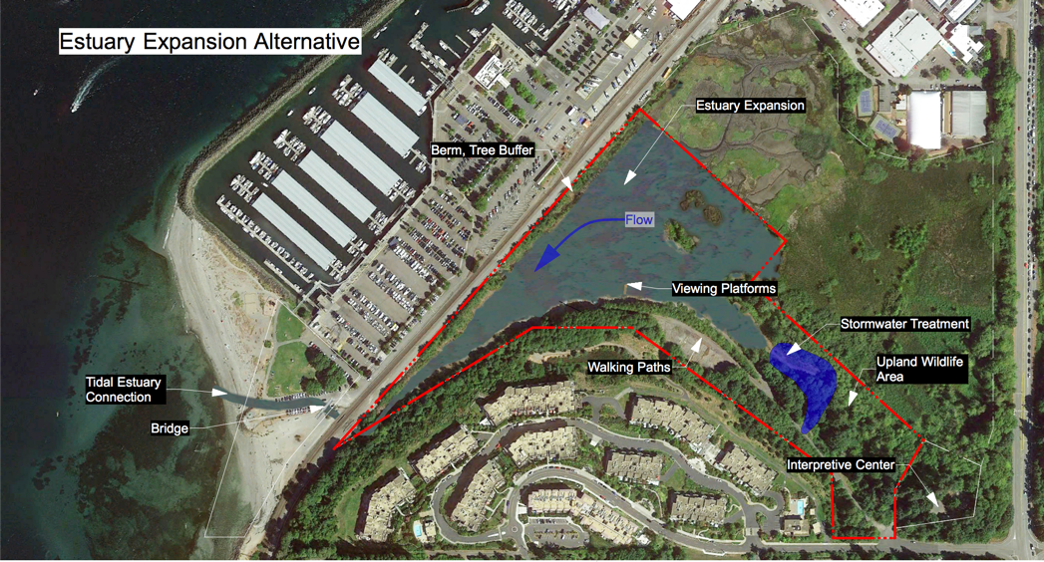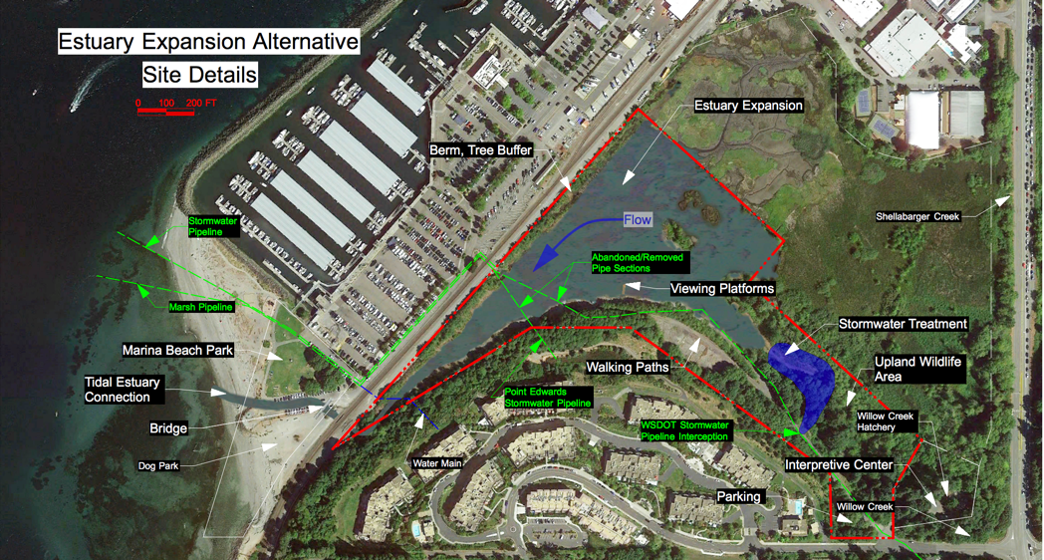Marsh Restoration and Estuary Expansion - Unocal Proposal
11/03/22
Summary
An approach recommended by the Edmonds Marsh Estuary Advocates as one important component of a comprehensive Edmonds Marsh restoration effort is described here. The marsh to Puget Sound reconnection segment would be through a tidal saltwater estuary. Removing fill from half of the Unocal parcel would reclaim a large area of highly valuable habitat.
An expanded estuary would support the recovery of Chinook salmon through the restoration of rearing and prey species’ production habitat. Other aquatic and avian species also benefit.
Due to the regional importance of creating more of this rare ecosystem in Puget Sound, this plan would expand the size and availability of funding sources that could support land purchase and restoration. Along with ecological and funding advantages, proposal benefits include increased flood water storage capacity, reduced risks due to contaminated soils, the treatment of polluted stormwater, and improved recreational opportunities for Edmonds citizens and visitors.
The Expanded Estuary Concept
The figure below shows the current location and condition of the Unocal parcel. Most of the site consists of petroleum-contaminated fill that covers a historic saltwater estuary.
Figure 1. The Edmonds Marsh and UNOCAL Site
The diagram below shows the basic elements of the proposed expanded estuary concept. The connection channel traversing the Unocal parcel proposed in earlier restoration evaluations (Final Feasibility Study Willow Creek Daylighting Edmonds, Washington, Shannon and Wilson, 12/18/15) is replaced by an open saltwater estuary bordered by the Point Edwards bluff, the existing Edmonds Marsh, and the BNSF railroad tracks.
Figure 2. Estuary Expansion Alternative (shown at high tide)
This proposal could be part of a comprehensive restoration plan that includes reconnection of the marsh/estuary to Puget Sound with a tidal estuary connection, developing a wildlife sanctuary and regional park, protecting marsh/estuary water quality and vegetation, and restoring watershed creeks.
Estuary Expansion Details
Figure 3. Proposal details
The proposed excavation of the Unocal lower yard is shown outlined in blue above. Removing fill creates 10 new acres of estuary habitat.
Assuming that the site is excavated to a maximum depth of two feet below the estuary connection channel bottom elevation, there would be approximately 100,000 cubic yards of material removed. This excavation depth provides open water habitat at all tidal elevations.
An island is left in the estuary to provide nesting birds protection against predators.
Excavated soils are proposed to be used to form an earthen berm on the northwest edge of the site along the BNSF tracks. The purpose of the berm is to protect the estuary from railroad impacts and to allow a vegetated buffer to develop. Excavated soils could also be placed in designated locations in the upland wildlife area.
Two underground stormwater pipelines (WSDOT 48” CMP and Edmonds Point 36” HDPE), shown in green above, and one water main, shown in blue, traverse the site. Sections of both stormwater pipelines, shown as gray dashed lines, would be removed or abandoned, allowing stormwater to flow into the estuary.
The WSDOT pipeline would be intercepted near the southeast corner of the Unocal parcel. A bioretention system, shown as a place in blue, would be installed between this interception and the estuary. This stormwater pipeline drains a large upstream area and carries up to 15 cubic feet per second of flow at times. As a result, treating this water would require a comprehensive watershed management plan.
The section of the stormwater pipeline extending from the railroad tracks into Puget Sound would be left in place to carry emergency flood flows. The existing Willow Creek pipeline would be left in place as well.
The regional park would include interconnected nature trails, interpretive sites, viewing platforms, and wetland boardwalks for outdoor recreation and fish and wildlife viewing.
Proposal Benefits
This restoration alternative provides the unique opportunity to reclaim some of the historic tidal wetland area that was lost to development. Benefits include:
Puget Sound Health
Most tidal saltwater estuary habitat has disappeared in Puget Sound. One estimate (Recommendations to Accelerate Estuary Restoration in Puget Sound, Paul Cereghino, NOAA Restoration Center June 2015) is that 75% is gone. Nutrient rich and penetrated by sunlight, this habitat is some of the most bilologically productive on earth. Estuaries provide a nourishing foundation that supports the wide range of life in Puget Sound.
Salmon Recovery
Several federal and state agencies have confirmed the importance of this type of environment for salmon recovery. For example, the Pacific Fishery Management Council has listed estuaries as a salmon HAPC, “Habitat Area of Particular Concern.” Chum and coho salmon would spawn in the creeks that feed the Edmonds Marsh-Estuary and their young would rear in its open waters. Juvenile Chinook salmon would also migrate from the Sound into the estuary to feed.
Other Fish and Wildlife
Estuaries also provide critical habitat for millions of migratory and resident waterfowl. This tidally influenced open saltwater area on the Edmonds waterfront would become priority bird habitat.
Estuaries are nursery ecosystems for multiple aquatic species. Dungeness crab, starry flounder, English sole, and bay shrimp are among the animals using estuaries at various life stages.
Funding
Due to the regional importance of creating more of this rare habitat in Puget Sound, the size and availability of funding opportunities is expanded. Salmon recovery, national estuary, nearshore restoration, wildlife enhancement, outdoor recreation, and other programs are grant funding sources that may be available.
Flood Elevations
The removal of fill will significantly increase the flood storage capacity of the marsh estuary. Flood elevations will be reduced, and flood walls and berms identified in other design reports may not be needed. Hydraulic modelling can determine the expected reduction in flood impacts.
However, although this alternative minimizes flooding, the eastern border along Highway 104 may require berming to prevent flooding that will result from the expected future rise in sea level. The Shellabarger culverts under the roadway may require flood gates.
Contaminated Soil Risk
Removal of the Unocal lower yard soils minimizes the risks to the property owner of finding areas of contamination missed during the WSDOE/Chevron clean-up. It also reduces the potential for continued groundwater contamination that could result from soils that contain remaining low levels of petroleum byproducts.
Water Quality
Untreated stormwater is considered one of the principal problems for Puget Sound health. Intercepting and treating stormwater from SR104 can help reduce the impact that Edmonds has on the water quality of the sound.
Estuaries also have more general water quality benefits. They help filter and settle out pollutants and nutrients.
Site Clean-Up
Areas of the Unocal site that still have high levels of contamination include soil surrounding the stormwater pipelines. This estuary excavation approach would complement and expedite the MTCA cleanup of the Unocal site by allowing the removal of those pipelines and the excavation of these remaining contaminated soils.
Recreation
As an important part of a regional park and wildlife sanctuary, the expanded estuary would attract both residents and visitors to Edmonds. The open water estuary habitat would increase the numbers and species of birds to be viewed, and adult salmon would migrate through the park. Unique educational opportunities are created with estuary habitat near an urban center.
Conclusion
The multiple benefits of expanding estuary habitat at the Edmonds Marsh make it an alternative that should be evaluated as the possible preferred alternative for Edmonds Marsh restoration.
The City’s public GIS system illustrates five critical area designations of the Marsh and surrounding areas
including the UNOCAL property. You can view them HERE.
A RELATED POTENTIAL DESIGN PROPOSAL FROM THE CITY PARKS DEPARTMENT
The restoration would include creating an open channel for Willow Creek from the marsh to the sound with a re-design of Marina Beach Park.
Here is a possible park re-design, a work in progress as provided by the Edmonds City planners.
Compare Marina Beach Park as it is now with the Marina Beach Park re-design, a potential city project plan.




